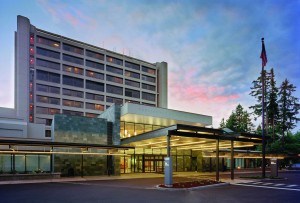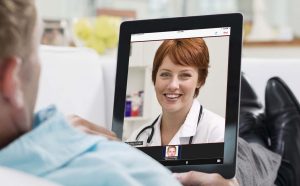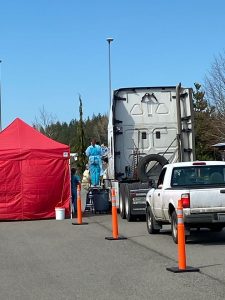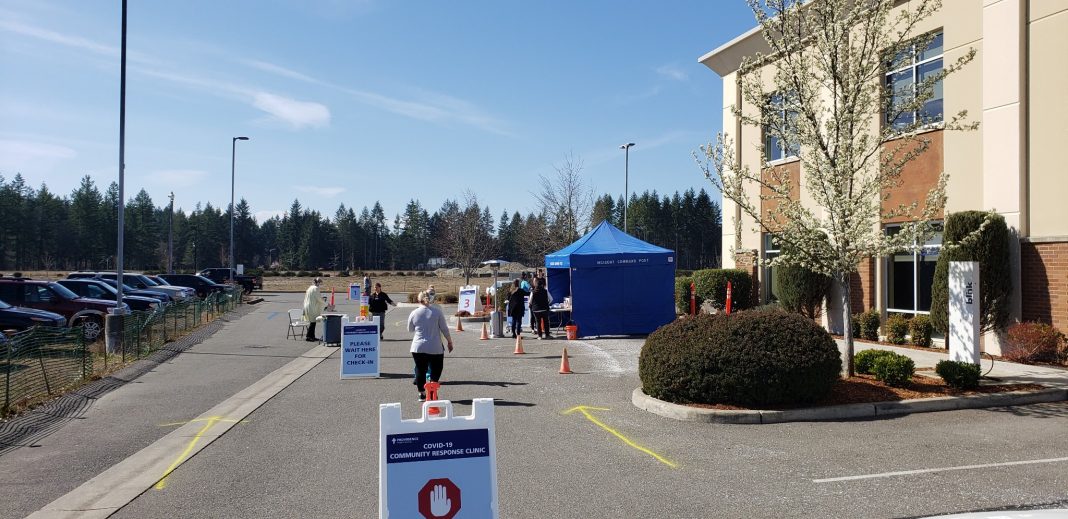For more than 130 years, Providence in Southwest Washington has seen to the health and safety of the communities it serves. The COVID-19 pandemic, once again, reflects the capability of Providence to quickly and effectively respond to crises in our community.

There are two main components to Providence Southwest Washington’s COVID-19 response efforts:
- The actions taken at its hospitals – Providence St. Peter Hospital and Providence Centralia Hospital
- The response of Providence Medical Group’s dozens of primary care and specialty care clinics
It’s important to understand these actions individually and the symbiotic relationship they form when working together to fully understand the breadth and scope of Providence’s pandemic preparedness.
Providence Virtual Care
Providence has offered telehealth, or as they call it, ‘Express Care Virtual,’ for a long time, but the COVID-19 pandemic “was the spark that lit us on fire for ramping up the scope of our telehealth program,” says Russell Igoe, chief operations officer for Providence Medical Group in Southwest Washington.
“We realized very quickly that our patients were going to need care,” says Igoe. “We had to align the technology with bringing the providers and care assistants up to speed. We have about 200 providers now, between our primary care and our specialty clinics, who are equipped and ready to perform the Virtual Care visits. We had a day last week where we had over 500 Virtual Care visits in one day—we have been seeing that number double every week for the last three weeks that we have ramped up Virtual Care.”
During this pandemic, telehealth has allowed Providence to relieve a great deal of stress on their hospitals. Igoe explained they added a home monitoring feature to their virtual care to monitor patients with mild COVID-19 symptoms and those currently recovering. “For patients being discharged from the hospital, or for COVID-19 positive patients,” he explains, “the best way to treat themselves is to stay home, isolate, and recover. And part of what that looks like is in-home monitoring.”

As of right now, Providence has about 1,000 patients across its seven-state healthcare system who are utilizing the home monitoring telehealth feature, and it has helped decrease the risk of disease spread—and ultimately helped relieve some of the pressure on their healthcare system.
Another benefit to their telehealth system is that it frees up some of the lower acuity needs to make room for emergency room space in their hospitals.. Since the start of the pandemic, Providence has seen a decrease in emergency room visits and they want the public to know that if they have a medical emergency, call 9-1-1 or go to the emergency department.
Drive-through Testing Offers Option for the Community
Since March 20 at its Hawks Prairie Clinic, Providence has offered drive-through swab collection for those who have COVID-19 symptoms. About 2,000 in the community have taken advantage of this service.
People are encouraged to call the drive-through hotline at 360-486-6800 before coming. Providence Medical Group’s Hawks Prairie Clinic is located at 2555 Marvin Road NE in Lacey.

Symptomatic patients include those with a fever, and/or new cough or congestion or shortness of breath, or sudden loss of taste or smell. Any “worried well” patients will not be tested, and given education on how to monitor symptoms.
Drive-through hours are:
- Monday-Saturday 10:30 a.m. to 4:30 p.m.
- Sunday 11:30 a.m. to 3:30 p.m.
Providence Hospitals and their Pandemic Response Efforts
From the get go, Providence hospitals have responded quickly and effectively to ensure the health and safety of its caregivers and the community. “I would say the first thing is obviously protecting our caregivers, and serving the needs of the community,” says Kevin Caserta, chief medical officer for Providence hospitals in Southwest Washington. “And so we want to make sure our caregivers are safe and that means utilizing the appropriate PPE (personal protective equipment), and it’s also the ongoing attention to detail that our caregivers have.”
Providence has spent the last month positioning themselves to be able to expand their capacity and capabilities, should the need arise. “We have expanded our critical care capacity and our med surge capacity to be able to take in anyone who requires a bed in our inpatient facility,” says Suzie Scott, chief nursing officer for Providence Southwest Washington. “We’ve also educated our staff and been able to cross-train the nursing staff to be able to cover units they don’t normally work on,”
What the community needs to know is that their hospitals are prepared to receive you, should you need the help. Transparency of symptoms is crucial to ensure the safety of their staff and other patients in the hospital, but all protocols are in place to safely receive patients who are experiencing COVID-19 symptoms.
Looking Forward for Providence
What does the future hold for Providence? It looks bright.
Igoe says this has been a game changer in telehealth and how they interact with their patients. Many in their group have already begun to think of how their model of care will change in the future because of this. How they take care of patients will evolve and get better. What this really does is it gives them a fresh look at what access to healthcare really is, and how they can serve their community in even greater way.
As a message of hope to the community, Angela Maki, director of Communication and External Affairs for Providence in Southwest Washington, said:
“Providence has been here in our community for more than 130 years. We cared for people through the Spanish flu pandemic. We are caring for the vulnerable in our community through the COVID-19 pandemic. And we are going to be here for the next 150 years to care for people during whatever crisis comes our way next. And that’s not going to ever falter; we will always be here to care for our community.”
Sponsored

















































